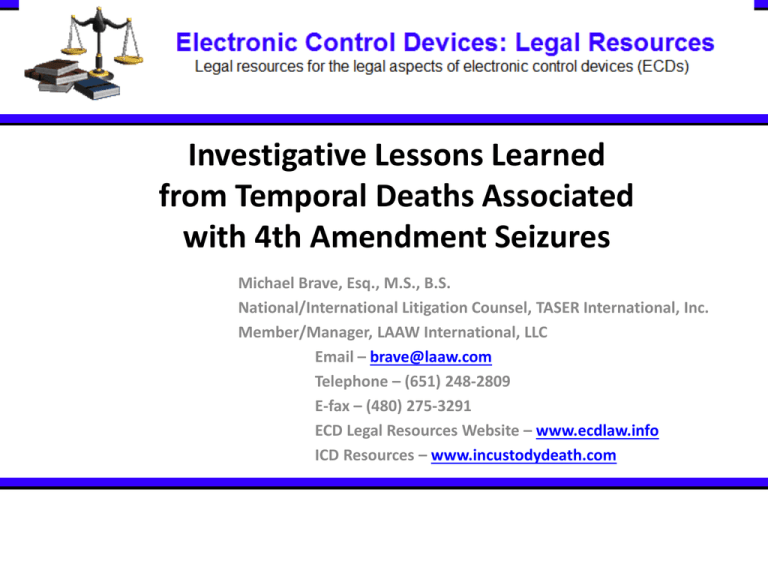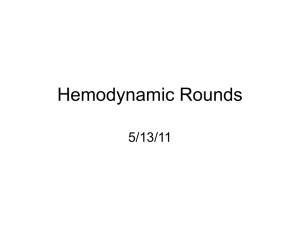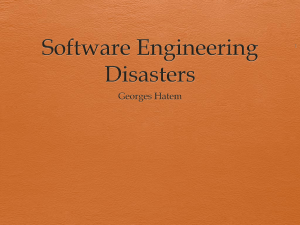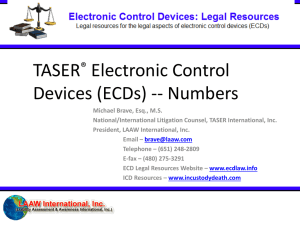Brave - 2013 IPICD Annual Conference Presentation PowerPoint
advertisement

Investigative Lessons Learned from Temporal Deaths Associated with 4th Amendment Seizures Michael Brave, Esq., M.S., B.S. National/International Litigation Counsel, TASER International, Inc. Member/Manager, LAAW International, LLC Email – brave@laaw.com Telephone – (651) 248-2809 E-fax – (480) 275-3291 ECD Legal Resources Website – www.ecdlaw.info ICD Resources – www.incustodydeath.com www.ecdlaw.info • I am not picking on anyone. • I have never seen what I consider even a very good such death investigation. • They are so rare we have to learn from what others have done, or failed to do, in the past. • Since the early 1990s I have looked at hundreds of such incidents or cases. • < 1 per career CHANGING PRESENTATION GEARS (DR. MASH) Changing Presentation Gears as Dr. Mash said – there will be more CEW electrical effect on heart deaths – due to the literature – why????? Zipes’ “Case Series” May 22, 2012 Logical Fallacies: • Aggrandizement: (Zipes 2012) “It is clear from the information cited above that an ECD shock to the chest can produce cardiac electrical capture at rapid rates in animals and humans.” (emphasis added) • Circular Reasoning: (Zipes, 2012) "Although it is possible that body size might influence cardiac capture and development of VF, clearly big people can still develop VF from an ECD shock (see the Table).“ (largest 220 pounds) What does this mean? CIRCULAR JUNK SCIENCE EXAMPLE Circular Junk Science Example: (Zipes 2012) "The concept of cardiac capture by transthoracic electrical impulses in humans was pioneered by Zoll,8 replicated by many others subsequently,9 and is now a standard part of resuscitative equipment. The threshold for transthoracic cardiac electrical capture is 100 microcoulombs,10 which is the output of the TASER model X26.1 Circular Junk Science Example: (Zipes 2012) 1. The concept of cardiac capture by transthoracic electrical impulses in humans was pioneered by Zoll,8 2. replicated by many others subsequently,9 and 3. is now a standard part of resuscitative equipment. 4. The threshold for transthoracic cardiac electrical capture is 100 microcoulombs,10 5. which is the output of the TASER X26.1 Perceptions from Zipes Case Series: • Is “cardiac capture” dangerous? • What is the electrical charge necessary for transthoracic cardiac capture? • What is the electrical charge delivered by a TASER X26 CEW? • Thus, does scientific literature establish that an X26 CEW causes cardiac capture? • Thus, does this establish that an X26 CEW causes death by direct electrical stimulation of the heart? Myerburg Editorial May 22, 2013 Circular Junk Science Example: (Myerburg Editorial (Zipes 2012) "Both clinical concepts and experimental data support this and are well summarized in Zipes’ discussion.2 The most salient points are that the energy delivered by the device is sufficient to achieve transthoracic capture when delivered to the anterior chest, analogous to clinical transthoracic pacing,7 in combination with a rate of stimulation that is sufficient to induce ventricular fibrillation." Circular Junk Science Example: (Myerburg Editorial (Zipes 2012) 1. Both clinical concepts and experimental data support this and are well summarized in Zipes’ discussion.2 2. The most salient points are that the energy delivered by the device is sufficient to achieve transthoracic capture when delivered to the anterior chest, analogous to clinical transthoracic pacing,7 3. in combination with a rate of stimulation that is sufficient to induce ventricular fibrillation. Perceptions from Zipes/Myerburg: • Is “cardiac capture” dangerous? • What is the electrical charge necessary for transthoracic cardiac capture? • What is the electrical charge delivered by a TASER X26 CEW? • Thus, does scientific literature establish that an X26 CEW causes cardiac capture? • Thus, does this establish that an X26 CEW causes death by direct electrical stimulation of the heart? Circular Junk Science Example: (Zipes 2012) 1. The concept of cardiac capture by transthoracic electrical impulses in humans was pioneered by Zoll,8 EN 8 - Falk RH, Zoll PM, Zoll RH. Safety and efficacy of noninvasive cardiac pacing: a preliminary report. N Engl J Med. 1983;309:1166 –1168. Circular Junk Science Example: (Zipes 2012) 2. replicated by many others subsequently,9 EN 9 - Klein LS, Miles WM, Heger JJ, Zipes DP. Transcutaneous pacing: patient tolerance, strengthinterval relations, and feasibility for programmed electrical stimulation. Am J Cardiol. 1988;62:1126 – 1129. Circular Junk Science Example: (Zipes 2012) EN 9 – Klein LS … Zipes DP 1988 Also, the 1988 Klein paper (their Fig. 2) showed that it took another 20 mA (milliamperes) (= 800 µC) to get more rapid pacing similar to that attainable with an internal pacemaker. And, this was at a pacing rate still far slower than the rate required or necessary to induce ventricular fibrillation (VF). Circular Junk Science Example: (Zipes 2012) 3. is now a standard part of resuscitative equipment. Circular Junk Science Example: (Zipes 2012) 4. The threshold for transthoracic cardiac electrical capture is 100 microcoulombs,10 EN 10 - Grimnes S, Martinsen OG. Clinical applications of bioelectricity. In: Biomedical Engineering Desk Reference. 1st ed. New York, NY: Elsevier; 2009:241–382. Circular Junk Science Example: (Zipes 2012) EN 10 – Grimnes In the 1964 Zoll paper, cited in the Grimnes treatise, statement that the researchers used “long subcutaneous precordial needles” (emphasis added) references endnote 4 (of the 1964 Zoll paper). Endnote 4 is: Zoll, P. M., H.A, Frankl,. R.N. Zarskya, J. Linenthal & A.H. Belgard. 1961. Long-term electric stimulation of the heart for Stokes-Adam disease. Ann. Surg. 154: 330. Circular Junk Science Example: (Zipes 2012) 5. which is the output of the TASER X26.1 EN 1 - Test results for the Model X26 conducted energy weapon (CEW) in accordance with TASER International device specifications. April 22, 2009. Report A85R9006/9031/9059B1. Circular Junk Science Example: (Myerburg Editorial (Zipes 2012) The mot salient points are that the energy delivered by the device is sufficient to achieve transthoracic capture when delivered to the anterior chest, analogous to clinical transthoracic pacing,7 EN 7 - Falk RH, Zoll PM, Zoll RH. Safety and efficacy of noninvasive cardiac pacing. A preliminary report. N Engl J Med Sci. 1983;309:1166 –1168. Circular Junk Science Example: Zipes: EN 8 - Falk (1983) EN 9 – Klein, Zipes (1988) - for higher capture rate EN 10 – Grimnes (Zoll) EN 1 – TASER X26 Myerburg: EN 8 – Falk (1983) MINIMUM Pacing Tresholds 1,680-3,200 µC 1,800-4,000 µC + 800 µC “long precordial needles” 100 µC 1,680-3,200 µC Perceptions from Zipes/Myerburg: • Is “cardiac capture” dangerous? • What is the electrical charge necessary for transthoracic cardiac capture? • What is the electrical charge delivered by a TASER X26 CEW? • Thus, does scientific literature establish that an X26 CEW causes cardiac capture? • Thus, does this establish that an X26 CEW causes death by direct electrical stimulation of the heart? Circular Junk Science Example: Falk (1983), Klein/Zipes (1988), Grimnes/Zoll: - MINIMUM “HARMLESS” capture thresholds - NO dangerous capture rates - NO VF or cardiac arrest (NO one died) Pediatric transthoracic capture threshold: - 1,160–3,920 µC - 53 of 56 patients (ages 0.9–17.9 years) resulted in successful capture Transcutaneous Cardiac Capture to VF Safety Margins: - 12.6 ± 2.9 times or 1,260 % PYRAMID OF SCIENCE “CASE SERIES” Circular Junk Science Example: (Zipes 2012) 1. Zipes 2012 “case series” In no death incident did the medical examiner (ME) determine that the cause of death was direct CEW electrical stimulation of the heart. 2. Inappropriately aggrandize “case series” to methodologically reliable science 3. Some MEs now use Zipes’ case series as their support for concluding CEW electrically induced cardiac arrest Case Series Not Reliable for Causation (the Pyramid of Science) Case Series Not Reliable for Causation “Case series generally provide weak evidence of causality because they are particularly prone to bias and confounding.” In the hierarchy of scientific evidence, a case series has very important weaknesses, including: "[l]ack of comparison group markedly limits conclusions about causality" and "[r]isk, incidence, prevalence cannot be ascertained" SHOW HUMAN PDF CEW DTH Distance ≤ 16.7 mm May 24, 2012 Zipes’ deposition (pgs 159-160) 24 Q … can you state to a reasonable degree of 25 certainty that any dart-to-heart distance greater 1 that 16.7 millimeters can cause low rate cardiac 2 capture in humans? 3 A I have no data. I can't state one way or another. First Need Cardiac Capture May 24, 2012 Zipes deposition (pgs 164-165) 21 Q When we left, we were talking about cardiac capture. 22 Just to be clear, the first element or factor 23 necessary in order to have cardiac effect on a human 24 being from the stimulation by a TASER electronic 25 control device is cardiac capture, correct? 165 1 A Yes. Logical Fallacies: • Inappropriate Analytical Leaps "In 1 example, intravenous epinephrine in an anesthetized pig, infused at a concentration that increased the spontaneous sinus rate 50% to replicate the clinical “fight or flight” situation, improved the TASER model X26 electrical capture ratio from 3:1 to 2:1 and resulted in VF induction.12“ [Zipes, D.P. 1975. Electrophysiological Mechanisms Involved in Ventricular Fibrillation. Supplement III to Circulation, Vols. 51 and 52, December, 1975, pages III-120 - III-300.] - (Epinephrine initially decreased VFT, then increased VFT. ) SHOW 220 POUND SUBJECT PDF Temporal Deaths Associated with 4th Amendment Seizures: How Much Risk is Acceptable? What probability of risk is acceptable? • Criminal prosecution • Justified civil lawsuit • Money • Political • Community What is the definition of “zero?” How much effort, time, resources, money will be put into the death investigation? INVESTIGATIVE REALITIES Investigation Realities: • Frequency: < 1 per career • Cannot identify issues • Do not access literature – Mis-assumes all literature is equally reliable • Do not know what to look for • Investigative bias/fallacies • Do not know importance of capturing certain information/evidence • Failure to capture, maintain evidence • False evidence Investigation Realities: • Evidence errors (ambiguous, vague, transcription, bad questions) • Failure to clear conflicting evidence • Do not know the universe of possibilities • Does not understand/clearly state certainty • Do not know how to filter in/out specific possibilities • Do not know the literature • Do not know the underlying scientific principles, foundational concepts Start With a Couple Key Points • • • • Once in a career, or less Understand the risks faced today (including CRM/DOJ) Use radio to clearly time stamp key events Understand that without clear video/audio recordings courts are usually required to view facts from subject’s perspective • Understand that some judges will interpret facts of case through their eyes, not yours • Understand importance of reporting, investigation, documentation, and spoliation of evidence • Understand differences between “possible,” “potential,” and “probable”(4th Amendment force justification) Investigation Basics: • • • • • • Purpose of Investigation? Who will investigate? Who will be involved/included in investigated? Who is the investigation for? What should the investigation do/allow? Who will make decisions based upon the investigation? WHAT ARE THE NUMBERS Estimates: Law Enforcement Encounters, Arrests, Force, Deaths Event (estimates) US Population (2010) Total Number Ratio Rate 308,745,538 1:1 100% 39,914,000 1:6 16.9% Force Used or Threatened on those FTF Contacts (2008) 776,000 1:51 1.4% Force Used Against Them Felt Force Excessive (2008) 447,000 1:1.74 74.3% 61,249 1:7.3 13.7 308,745,538 1:1 100% 13,122,000 1:23.5 4.2% 196,830 1.5–2:100 600 1:328 Police-Public Face-to-Face (FTF) Contacts (total) (2008) Force, Person Believed Excessive Filed Complaint Arrest – Force – Death Numbers (estimates) US Population 2010 Arrests (2010) (BJS FBI statistics and definitions) Force Used Per Arrests (calculated 1.5%) Deaths Per BJS/FBI Arrests (estimated) [1] Snyder, H.N., Arrest in the United States, 1990-2010. Bureau of Justice Statistics, Office of Justice Programs, U.S. Department of Justice. October 2012, NCJ 239423. 0.003% Law Enforcement Officer (LEO) Temporal Related Deaths Per Category Summary Table Category of deaths (mortality) Deaths per temporal factor LEOs use of weapons deaths Pepper spray deaths per uses Jail inmates deaths per year LEOs deaths per year Arrests deaths per arrests 1 death per 323 arrests using weapons 1 death per 600 uses of pepper spray 1 death per 658–709 jail inmates 1 death per year for every 5,521 LEOs 1 death per 15,384.6 arrests Deaths per 100,000 of specific incident 150 per 100,000 inmates 18 per 100,000 LEOs 6.5 per 100,000 arrests Estimates: Temporal Arrest–Related Deaths per Uses of Force 2013 Hall 2012 Hall 2010 Strote 2009 Bozeman 2008 Eastman 2003 Koehler [1] (all uses of force) (all uses of force) (CEW study) (CEW study) (CEW study) (all uses of force) # Uses of Force 4,992 1,269 1,101 1,201 426 Deaths Ratio 7 1 0 2 1 1:713 1:1,269 0:1,101 1:600 1:426 Rate (%) 0.14 0.07 0.00 0.01 0.02 Hall, C. 2013. RESTRAINT . Canadian Police Research Centre, Canadian Safety and Security Program, Government of Canada. October 2013. Hall, C.A., McHale, A., Kader, A.S., Stewart, L.C., MacCarthy, C.S., Fick, G.H. 2012. Incidence and outcome of prone positioning following police use of force in a prospective, consecutive cohort of subjects. Journal of Forensic and Legal Medicine xxx (2012) 1–7. [3] Strote J, Walsh M, Angelidis M, Basta A, Hutson HR., Conducted electrical weapon use by law enforcement: an evaluation of safety and injury, J Trauma. May 2010; 68(5):1239–1246. [4] Bozeman, W.P., Hauda, W.E., Heck, J.J., Graham, D.D., Martin B.P., Winslow, J.E. 2009. Safety and Injury Profile of Conducted Electrical Weapons Used by Law Enforcement Officers Against Criminal Suspects. Annals of Emergency Medicine. Volume 53, Issue 4, Pages 480-489, April 2009. [5] Eastman, A.L., et al., Conductive electrical deces: a prospective, population-based study of the medical safety of law enforcement use, J Trauma, 2008, 64(6): p. 1567–72. [6] Steven A. Koehler, MPH, PhD, et. al., Deaths Among Criminal Suspects, Law Enforcement Officers, Civilians, and Prison Inmates: A Coroner-Based Study, The American Journal of Forensic Medicine and Pathology, pages 334–338, Volume 24, Number 4, December 2003. [2] 2013 Basic Numbers Importance of putting issues and outcomes into perspective Some Basic Numbers (Law Enforcement) (percentage of populations (approximate numbers with different years of analyses)) Who law enforcement encounters (population %): • 4.3 % (1:23) DUI illicit drugs (of age 16+ population) • 8.7 % (1:11.5) Current Illicit Drug Users (of age 12+ population) • 8.9 % (1:11.2) Classified with substance dependence or abuse in past year based on DSM-IV criteria • 10.9 % (1:9.2) In Serious Psychological Distress (“SPD”) Law enforcement numbers (percentages): • 17.0 % of U.S. population had LEO Face-to-Face (“FtF”) encounters (annually) • 1.4 % of LEO FtF encounters involved LEO threaten/use force • 2.1 % of LEO arrests involved LEO’s use of weapon • 19.0 % of LEO force recipients reported injuries • 75.0 % of force recipients felt LEO’s force was excessive Some Basic Numbers (Deaths) • • • • • • • 1.6 deaths per 100 hospital ER admissions (weekdays) 1.8 deaths per 100 hospital ER admissions (weekends) 1 death per 126 people in U.S. population (annually 2009) 1 death per 323 LEOs’ uses of weapons 1 death per 600 LEOs’ uses of pepper spray 1 death per 700 persons jailed 1 Sudden Cardiac Death (“SCD”) per year: – 1,282 NCAA basketball black male athletes – 3,126 NCAA basketball all Division I male athletes • 1 death per 5,521 LEOs (annually) • 1 death per 7,692 Military recruit-years (non-traumatic) • 1 death per 15,385 arrests Some Basic Numbers (of deaths annually (2009)) 2009 - US Population Death/Mortality Numbers: • 1 death per 126 people in the population – 2009: 307,006,550 people ÷ 2,436,682 deaths = 125.9937 2009 - Of those 2,436,682 deaths: • 1 death for every 18.81 people who died was caused by drugs, suicide, firearms, or alcohol • 1 death for every 65 people who died was caused by drugs (37,485 drug deaths) Basics Numbers: US Drug Deaths Basics Numbers: Specific Deaths STARTING AT THE END Starting at the End • • • • • Clearly identify ALL issues Fully research ALL issues Acquire relevant literature Share literature, outlines with others Accumulate ALL relevant: – Policies (including historical) – Training records – Daily records/logs • Create clear tables, charts, synopses • PREPARE witnesses for testimony Starting at the End • Consider: Testimony and decisions made 5+ years from incident? • Start with clear (annotated) timeline • Create reference tables, lists, outlines • Use optimal recording devices: – Video – Audio – Digital – Transcripts (VERIFIED accurate) – Copies (including color) Starting at the End Complete unambiguous documentation of events/evidence? • Bad documentation (first person or other?) – E.g. ER records – presenting: asystole, PEA, VT, VF • Eliminating as many facts issues as possible – Word definitions • E.g. “puncture” (probe or drive stun?) – Actions • “Shocked” or “Gave shock”? • Resolving fact issues and conflicts • Clear, precise terms, definitions, phrases Starting at the End • Complete annotated appendices (30 second) – Bankers boxes – Chronological pages – Same issue in multiple locations – Often 1,000 pages – Well organized (Bates stamped) – Consider reviewers, decision makers • Is all evidence admissible at trial - regardless of availability of witnesses? – E.g. officers unavailable – Confirmed by records custodians PLAINTIFFS’ / CRITICS’ OBJECTIVES What Are Plaintiffs'/Critics' Objectives? • Use or create fact issues to get to a jury • Litigate case based on emotion • Do not put the case into context or perspective • Litigate case founded on logical fallacies • 10,000 gallons of crap against the wall • Accumulate 42 USC 1988 attorneys' fees (Attorneys' Fees Award Act of 1976) INVESTIGATION BASICS Basics • At scene incident documentation – POV recordings – Motorola memory – Prevent loss/destruction of evidence • Identify all potential issues – Have to know what the issues are • Research all issues (and underpinnings) • Identify all potential evidence – Avoid loss or spoliation of evidence – Identify time sensitive evidence – Clearly delegate (in writing) evidence collection Basics • Investigation • Investigation documentation – Efficient organization – Bates stamping • Report creation – Complete annotated appendices • Locate any information within 30 seconds • Formulating conclusions • Decisions made based upon conclusions provided Realities of (4th Amendment) Seizure Temporal Death and Investigation: • Language - word meaning - differences – Words mean different things to different groups • Levels of certainty • Failure to determine degree of medical, scientific, forensic certainty • Supported by literature • Underpinnings of conclusions supported by literature • Logical Fallacies LOGICAL FALLACIES (EXAMPLE) Examples of Logical Fallacies: • • • • • • • • • • Causal over simplification Post hoc ergo propter hoc (temporality fallacy) Confirmation bias Argument from ignorance Quote mining Fallacy of quoting out of context Circular reasoning Correlation proves causation Appeal to authority fallacy Proof by verbosity INVESTIGATION KEY PARTICIPANTS Investigation Key Participants: (1) Incident Scene: (a) Dispatch supervisor (b) Dispatcher (c) Officers (d) On-Scene Supervisors Investigation Key Participants: (2) Post-Incident Medical Care: (a) Fire/EMS Personnel (including dispatcher) (b) Ambulance Personnel (c) ACLS/Paramedics (d) Hospital Personnel (ER, Nurses, Doctors) Investigation Key Participants: (3) Law Enforcement Supervisors/Trainers/Execs: (a) (b) (c) (d) Field Supervisors Trainers Middle-Level Supervisors Decision Makers Investigation Key Participants: (4) (5) (6) Elected/Government Interference Special Oversight Person, Groups Incident Investigators: (a) Investigators (b) Coroner/Medical Examiner Investigator (c) Special investigators (FBI, CRD (DoJ)) (7) (8) Medical Examiner, Coroner, Forensic Pathologist Specialty Pathologist, Toxicologist, Researcher Investigation Key Participants: (9) (10) (11) Media Family Members and Friends Special Interest Groups/Critics BASICS OVERVIEW Basic Concepts Overview: • • • • • • Junk Science Circle Degrees of Certainty Mechanism of Effect General - Specific Causation Scientific Reliability Investigation Realities: Basic Legal Concepts Basic Legal Concepts • Plaintiffs can allege (almost) anything • Plaintiffs’ primary goals: – To get attorneys’ fees (42 USC § 1988) – To get in front of a jury • • • • Law can be extremely flexible (discretion standard) Know some judges will not follow the law Know some judges are anti-law enforcement Know some judges/juries emotion over law or logic – To extort a settlement – Beware the anti-law enforcement crusader Basic Legal Concepts • Burden of proof in a civil case: – by a preponderance of the evidence – more likely than not – 50.1 percent • Summary judgment motion (MSJ): – court “MUST” take the facts as offered by the MSJ opposing party • UNLESS incident recording trumps party’s stated facts (Scott v. Harris, USSC) Basic Legal Concepts • Qualified immunity – Protection from suit – Two part test: • Constitutional right was violated • Law had put officer on notice that what he did was in violation of the constitution (excellent example is Bryan v. MacPherson (November 30, 2010) • Money: – Unlimited damages (for practical purposes) – 42 USC § 1988 attorneys fees (since 1976) Clearly Record the Incident • If available, use on-officer point of view (“POV”) incident recording equipment • When safe, use radio to establish record of significant events with dispatch time logs (call in): – Immediately at end of CEW use – Immediately upon subject being handcuffed – Person’s perceived medical status and condition (pulse (where taken), breathing, eyes open, alert, flailing, leaning, lying on left side, medical distress, etc.) Evidence Gathering* Capture all relevant evidence, including: • CEW probes and wires • do not allow items to be placed into biohazard container or destroyed. • Collect the clothing where CEW was applied • Photograph injuries and lack of injuries • Collect all relevant videos, audios, dispatch • Expeditiously download CEW firing data A “Few” Basic Numbers Person Deaths: (Involving Law Enforcement Officers (LEOs)): ~ 1 death per 15,385 arrests ~ 1 death per 700 people going to jail ~ 1 death per 600 uses of pepper spray ~ 1 death per 323 arrests using weapons Death Rate in Jails • (2000-2007) Local Jails (in-custody deaths): – 8,110 deaths in local jails from 2000 through 2007 – 1 death per 658-709 inmates (depending on year) • Rates of jail in-custody deaths: – Local Jails: 141-152 deaths per 100,000 inmates – Nevada: 247 deaths per 100,000 inmates – National average: 250 deaths per 100,000 inmates – Western states: 219 deaths per 100,000 inmates • Ontario: 211.5 deaths per 100,000 inmates







